-
Step. 01 Treatment
guidance -
Step. 02 Simulation
-
Step. 03 Establishment
of the treatment
plan -
Step. 04 Proton
Treatment -
Step. 05 progress
observation
01. Registration
-
International patients should first check in at the International Treatment Center upon arrival.
- After you make your decision to receive Proton Therapy, you will be guided to the Proton Therapy Center.
-
If you arrive at the Proton Therapy Center according to your appointment time, you will be able register without having to wait.
When using the kiosk, please insert your medical card and press the registration button after checking your name on the screen.
- After you have confirmed the message that you have been registered, please wait in the waiting room.

(1st floor of the basement)

(1st floor of the basement)
02. Guidance
-
If you are waiting in the waiting room, your name will be called.
You can check the waiting list through the electric display.
- You will receive information on proton treatment preparation, process, and schedules from the nurse in charge.
- Through a consultation with a specialized professor, proton treatment, treatment method, and the number of treatments will be determined.
- After the consultation, you will receive detailed information including proton treatment preparation, process, and schedules from the nurse in charge.
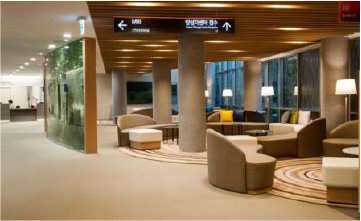
outpatient waiting room


03. Breathing exercises before the simulation
-
To precisely transfer radiation to the tumor in the body, a simulation is facilitated before the proton treatment.
- From this process, preparation for precise treatment, including producing supplement equipment for fixed posture and indicating treatment sites, is conducted. Subsequently, the image that will be used for the treament will be obtained.
- If there is a tumor in an area influenced by respiration movements such as the liver and lungs, an image will be obtained according to the patients respiration periods to precisely determine the range of treatment.

04. Contrast agent injection before the simulation
- During the imaging process, a contrast agent injection is administered in some cases to assess the exact position of the treatment site. In cases where a contrast agent injection is needed, the nurse will administer it to you before the simulation.


05. Production of fixed equipment
- In order for the radiation to be transferred precisely to the treatment site, you should stay still during the proton treatment.
- The fixed equipment that holds various postures is produced during the simulation for individual patients who have instable postures or difficulty in maintaining a lying position for a long period of time.
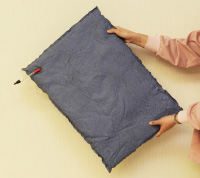


The fixed equipment production process
06. Equipments that keep your body posture fixed during the treatment

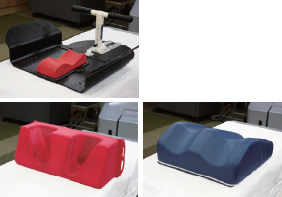

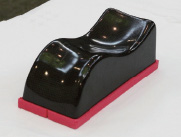
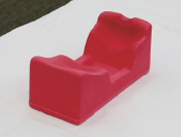
07. Production of masks for brain tumor/head and neck treatment
- In the case of brain tumors and head and neck tumors, plastic material masks are produced to indicate the treatment sites.
-
In a comfortable, lying down position, a shape modifiable plastic net is dipped into warm water and placed on your face to model it corresponding to your the shape of your face.
The plastic net that has been modified according to your face shape will harden as the temperature decreases, and after placing tape on the mask, it indicates the treatment site.




08. Simulation using a 4 dimensional CT simulator
- Computerized tomography simulation is a process that uses the 4 dimensional computerized tomography (CT) simulation device to assess the body structure through a 3 dimensional or 4 dimensional cross sectional image after deciding the treatment site and posture.
- A treatment plan established which consists of protecting the normal tissues as much as possible while maximizing treatment effects by identifying the exact location of the tumor with a similar posture image obtained during the radiotherapy.
-
During the imaging process, a contrast agent injection is administered in some cases to assess the exact position of the treatment site.
In cases where a contrast agent injection is needed, the nurse will administer it to you before the simulation


[4 dimensional computerized tomography (CT) simulation device]
09. Simulation using the MRI simulator
- MRI has an advantage of identifying the exact location of the tumor and its characteristics in the case that the patient’s treatment site is surrounded by air and bones.
- During the proton treatment, CT simulation and MRI simulation may be conducted together or only MRI simulation may be solely facilitated depending on the treatment site.

10. Indicating the treatment site
- After determining the treatment site through the CT and MRI, the precise location of the treatment site will be marked by drawing lines directly on your face using an oil based pen.
- The marked treatment site must be identified for every treatment. Therefore, taking a shower and application of lotion should be avoided as it may erase the marking. If the treatment period is extensive, a dot indication which is difficult to erase, will be marked for your convenience.
- Although the dot indicating method involves stinging sensations due to the use of a needle, the marks are very tiny so it is difficult to be seen visually. However, it has a disadvantage with the risk of it becoming permanently marked.
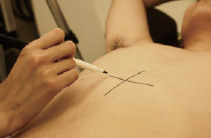

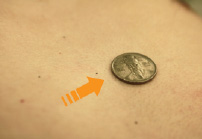
Marking the treatment site and tattoo process
11. Computerized planning
- When the treatment site is determined through the simulation, a most suitable treatment plan is created for the patient using a computer. It takes about more than 1 week from the production of the treatment plan to the actual treatment.
- This is a process where not only the doctor in charge, but medical physicists, dosimetrists, and radiological technologists closely get together to collectively discuss the most suitable treatment for the patient.

12. Review and approval of the treatment plan
- After the completion of the treatment planning, the doctor in charge will make the final review and approval to be sent to the treatment room.
- The transferred treatment plan is entered into the automated device and the automated device facilitates the treatment automatically.

13. Treatment registration
- After the completion of the treatment planning process, the actual treatment begins.
- If you have visited the Proton Therapy Center to receive proton treament, please go to the 3rd floor of the basement to register through the proton treatment room reception desk or use the registration kiosk.

(3rd floor of the basement)

14. Waiting and dressing
- Wait in the waiting room after registration and change in the dressing room before receiving treatment.


15. Cautions before entering the treatment room
- When actual treatment is in progress, no one except the patient can enter the room.
- The door of the treatment room is made of heavy metal with radiation resistance materials to prevent radiation leakage. Therefore, please follow the treatment supervisor’s instructions for safety.

※ If the patient is a child that needs anesthesia, change your clothes in the Anesthesia
Recovery Room to prepare for the anesthesia and enter the treatment room.
16. Check the location prior to the treatment
- When you lie on the treatment table, green and red laser lines will cross each other form a cross shape.
- The table will be moved to align the indicated line with your body. This is a guide to make sure that the radiation transfer is facilitated accurately according to the determined treatment site in the prior simulation.
- Please do not move until the treatment is completed. If those who have difficulties lying still, we will fix your position to help you get through the treatment.


17. Radiation transfer (control room)
- The supervisor of the treatment room will implement the plan according to the control room computer and all motions are automatically controlled through the computer.
- There is a mic installed in the treatment room, in the case you experience any inconveniences, please inform us anytime.
- Moreover, the treatment room is monitored through a CCTV to prevent any accidents.

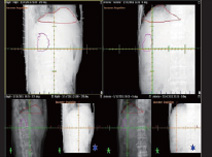
A scene that verifies the successful radiation transfer to the planned treatment site
18. Consultation with doctors
- Consultation with doctors is scheduled once a week during the treatment period.
- Please make inquiries of any inconvenience to our nurses at any time even without previously arranged consultations. Consultations are carried out in the treatment without any arrangements or appointments.
- The periodic follow-up procedures will be facilitated to assess the reaction from the treatment and to check for any side effects after the completion of the proton treatment.

